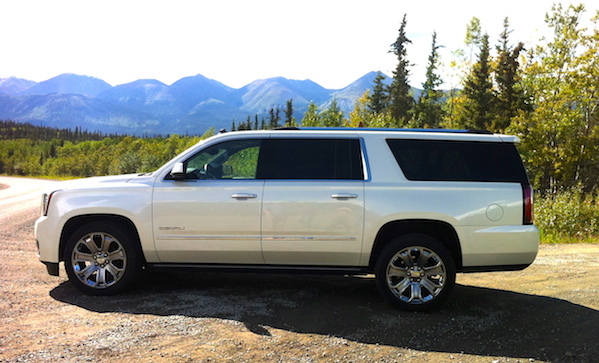Muddy Queen Street, Dawson City, YT — It’s midnight but the sky’s not quite dark. It could be twilight. Or the northern lights. Or the Bud Lights. We stowed the 2015 GMC Yukon XL Denali hours ago before hitting the town. But what a day it was: a series of real-life testing conditions for the Yukon’s assorted engineering features, unencumbered by inconvenient traffic or police, on the Klondike Highway.
We were up and out on the road at the crack of 9 AM, a convoy of Yukons gold-rushing its way 500km north from Whitehorse. The terrain is mountainous and majestic, appropriate inspiration for one of the largest SUVs you can buy. The road is mostly smooth but long stretches are dirt, sustaining maintenance works.
The Denali trimline has a 6.2 litre V8 engine with best-in-class horsepower, 420hp, and torque, 460 lb-ft. It’s quite responsive, getting from 0 to 60kph in under six seconds. Some stretches of bereft highway afforded plenty of playtime with the accelerator.
Once there was the need to test the brakes, rushing to sudden and complete stop until a young bear warming its ursine hind on the warm tar noticed us and darted away. Soon after, we sped hard again. Until . . .
“Oh shit, sorry, HOLE!!” At the last second, I noticed a wide, deep pothole and powered right over it, expecting a bone rattling. Fortunately, the shock absorbing system provided a smooth ride even over this valley-in-training.
Here’s my troglodytic understanding of two important aspects of the ‘magnetic ride control’ feature. One: it continually reads the road, reviewing conditions up to a thousand times per second. The result? Plenty of reaction time when those conditions suddenly change. Two: Minute magnetic particles float in the shock absorber’s polymer fluid. Electric charges continually reposition the particles to thicken or thin the fluid’s viscosity.
Depending on the charge, the fluid can become almost solid or rubbery, providing a smooth ride, even over potholes. Later, my drive partner raced maniacally along one circuitous and constantly tilting mountain road, observing “There’s almost no roll at all.”
The Driver Alert System regularly warns you when you’re approaching the edge of your lane with a jiggle to your backside. About a fifth of the ‘highway’ was unpaved and unpainted road, so the feature got less of a workout.
However even the Yukon Territories have some traffic, tight corners and parking lots, making the rear cross-traffic alert a boon. At one point, we were backing out from a space in the parking lot of a tourist attraction. Flanking us was an ancient RV with rickety seniors milling about and a rival full-size SUV releasing several untethered kids and dogs. At 5,697mm by 2,045 mm, the Yukon is a huge vehicle. It’s impossible to see everywhere, especially through the backs of the other vehicles where kids and seniors may be gamboling about.
Enter the rear-cross traffic alert! It noticed the children, seniors and dogs around the corners, invisible beyond the mirrors’ sights and lit bright exclamation marks on the rear-camera screen, punctuating the urgency of their crucial presence with arrows.
In a usually bereft place, here was an excellent demonstration of a valuable safety feature put to the test in real life—circumventing any need for police.
Be sure to check out part II tomorrow.
————
Though a co-owner and former editor of DailyXY, Steven Bochenek is actually an advertising writer who does some journalism on the side. In 2011 he was accepted into the Automotive Journalists Association of Canada. His other interests include playing music, long-distance running, skiing and writing in the third person.
—
Photo courtesy of the author.


